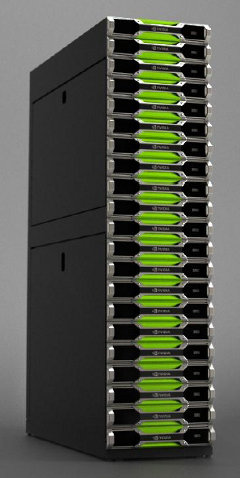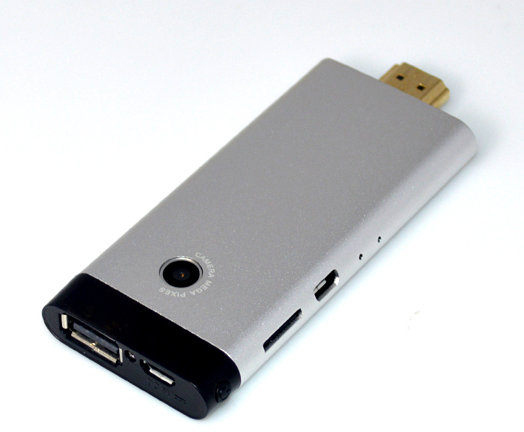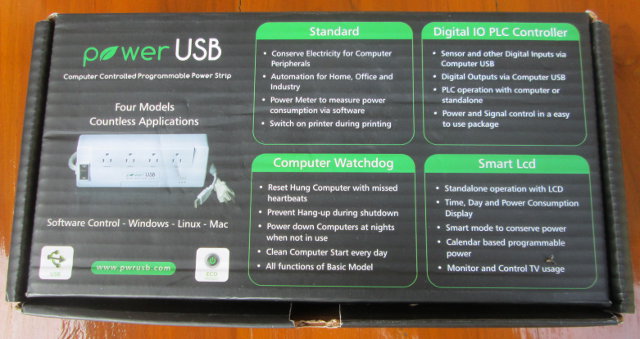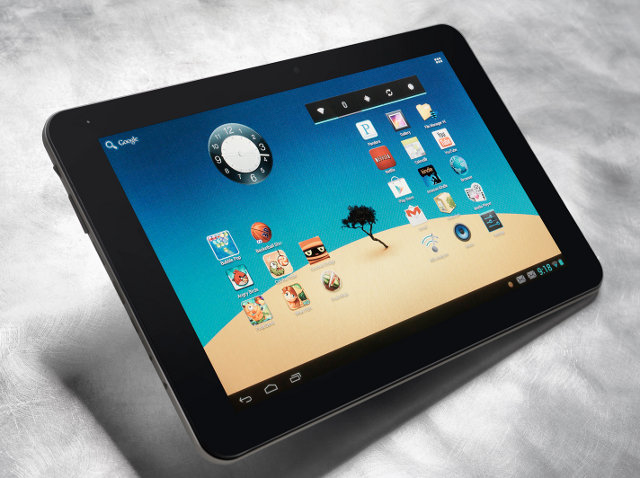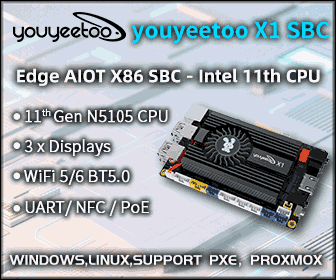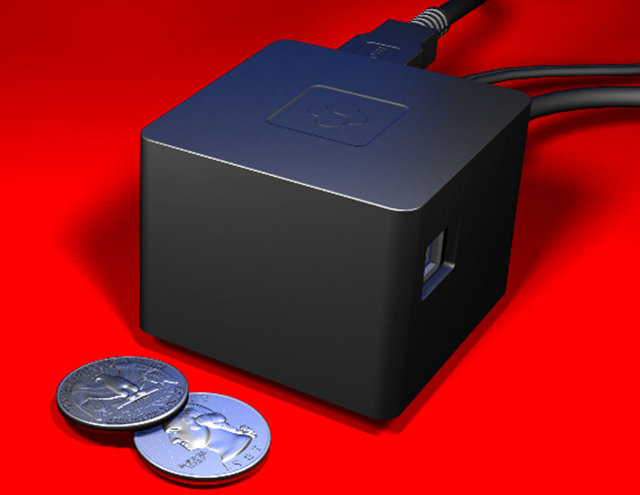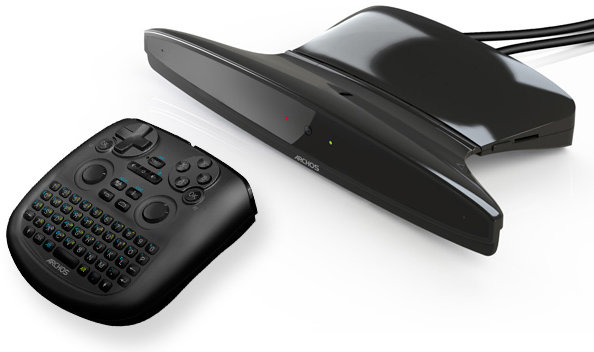CES 2013 has finally started, and Nvidia has had a pretty amazing keynote with some PC gaming announcements such as “GeForce Experience” which is a piece a software that can configure your games settings automatically based on your PC hardware (e.g. processor and GPU), and 3 cloud and mobile devices announcements: Nvidia GRID Platform – Cloud Gaming Server with 240 Nvidia GPUs. Nvidia Tegra 4 – Nvidia 4 cores Cortex A15 , 72 GPU and SDR modem SoC for tablets and smartphones. Nvidia Project Shield – Game console with a 5″ display powered by Tegra 4 that can also act as a game controller, and play PC games on your TV. Nvidia GRID Platform NVIDIA GRID Cloud Gaming Platform is comprised of 20 GRID server per rack with a total of 240 Nvidia GPU capable of 200 TFLOPS or the equivalent of 700 Xbox 360. Nvidia GRID render 3D graphics […]
Kimdecent B12 Rockchip RK3066 HDMI TV Dongle Features a 2MP Webcam
Kimdecent has added a new Rockchip RK3066 Android 4.1.1 mini PC to its offering. The device comes with 1GB RAM, 8GB Flash, Wi-Fi & Bluetooth connectivity, and a feature I’ve never seen in any other PC-on-a-stick: a 2 MP camera for video conferencing with Skype or Google talk. Apart from the webcam, the rest of B12 specifications are very similar to MK808: SoC – Rockchip RK3066 dual core Cortex A9 @ 1.6GHz + Mali400 quad core GPU System Memory – 1GB RAM Storage – 8GB ROM + microSD slot (up to 32GB) Connectivity WiFi 802.11/b/g/n 150Mbps Build-in Bluetooth 2.1 USB – 1x Full Size USB 2.0 + 2x micro USB ports Video Output – HDMI 1.4 output+ AV output Camera – Build-in 2MP webcam Audio I/O – Mic Misc – Hardware Standby key, software power off key, and recovery hole. Dimensions – 97.5 x 39.8 x 9.8mm Weight – 42g […]
$77.30 SAA-250 Telechips TCC8925 Board
Dealextreme is selling a board (Model SAA-250) featuring Telechips TCC8925 Cortex A5 processor with 1GB RAM, and 4GB Flash. They sell it as a “Android 4.0 DIY Intelligent TV Box / Advertising / Development Motherboard”, but it’s basically an Android set-top box board without casing, power supply, nor remote control, and you should not expect to do that much development (except Android app development) on it since no source code is available. Here are the board specifications: SoC – Telechips TCC8925 up to 833 MHz ARM Cortex A5 + 1080P VPU + Mali-400 GPU. (Dealextreme says it’s a dual core Cortex A5 up to 1.2 GHz, but if it’s TCC8925, that’s just plain wrong) System Memory – 1GB RAM Storage – 4GB flash + SD card slot Video Output – micro? HDMI 1.3 up to 1080p + CVBS AV output Video formats – RM/RMVB, MPEG, MKV, AVI, FLV, VP8 up […]
PowerUSB Computer Controlled Power Strips Review
PowerUSB power strips are four outlets power strips designed to help users save power by better understanding their devices power consumption, and automatizing tasks such as power on/off using timers, printer on/off controls, and more. One outlet is always on (for the main computer) and the 3 remaining outlets can be controlled via USB and the control software installed in a Linux, Mac or Windows x86 machine. The three of the four outlets are controlled through the software. Those power strips should allow lower electricity bills, and cover the cost of the strips ($69 to $129) within a few months. There are 4 models: PowerUSB Basic – $69.99 – The simplest model. You can control the 3 programmable outlets with on/off timers and keyboard shortcuts. PowerUSB Digital IO – $109.99 – This version adds 5 digital input/output lines for instrumentation and automation. The current model has 3 inputs and 2 […]
Ingenic JZ4780 SoC Features a Dual Core MIPS CPU and PowerVR SGX540 GPU
MIPS and Ingenic Semiconductor have just introduced the JZ4780, a low cost dual core MIPS XBurst processor with a PowerVR SGX540 GPU. The companies will demonstrate their solution in a 10″ Android 4.1 Jelly Bean reference tablet during CES 2013, on January 8 – 12, 2013. JZ4780 SoC Highlights: SoC – Dual XBurst core up to 1.5GHz CPU + PowerVR SGX540 GPU supporting 2D Graphics, 3D Graphic, OpenGL ES2.0 and ES1.0, OpenVG1.1 VPU – 1080P Decoder,1080p encoder Memory Interfaces – 8-bit SLC/MLC/TLC NAND Flash, 64 bit ECC |16/32-bit DDR3/DDR2/DDR/Mobile DDR SDRAM Peripherals – AC97/I2S/SPDIF, Audio Codec, LCD-IF, LVDS, HDMI, Camera-IF, Touch ADC,PCM, I2C, SPI,UART, SD/MMC/SDIO, USB Host, USB OTG 2.0, TS-IF, GPIO, OTP Power Consumption – Ingenic’s MIPS-Based XBurst processor is said to consumes approximately 140mW per GHz under full load. Package – BGA390 17 x 17 x 1.1 mm, 0.8mm pitch Process – 40nm CMOS Ingenic will also demonstrate […]
ZEALZ GK802 / HI802 mini PC Can Now Run Ubuntu 11.10
After Freescale made available i.MX6 development resources, we all knew this was a matter of time before Ubuntu runs on Hi802 / Zealz GK802 mini PC based on Freescale i.MX6. The guys at GeekBuying have done it, and a beta version of Ubuntu 11.10 can run on the Zealz GK802. This is not the first time Ubuntu or another Linux distributions can run on one of these mini PCs, but it’s the very first time we should get full hardware graphics and hardware video decoding in Linux. You may have noticed the screen is cut on the sides, that’s because they haven’t done overscan adjustment before shooting the video. They are using Ubuntu 11.10 (Linaro) because that’s the version released by Freescale that supports GPU and video acceleration, and if they used Ubuntu 12.04, it would not work until Freescale releases the proper drivers. However, scrolling does not seem particularly […]
$159 CuBox Pro: Open Source Development Platform Based on Marvell ARMADA SoC
Back in 2011, SolidRun unveiled the CuBox, a miniature open source development platform based on Marvell Armada 510 SoC (88AP510) and aimed at applications such as multimedia, set-top-box, network attached storage (NAS), thin client, digital signage, automation… SolidRun has now announced an upgraded version called CuBox Pro based on the same platform but with 2 GB RAM, and a redesigned casing. Here are the specifications of this development platform: Marvell Armada 510 SoC – 800 MHz dual issue ARM PJ4 processor, VFPv3, wmmx SIMD and 512KB L2 cache. 2GByte DDR3 at 800MHz 1080p Video Decode Engine OpenGL ES 2.0 graphic engine HDMI 1080p Output (with CEC function) Gigabit Ethernet, SPDIF (optical audio), eSata 3Gbps, 2xUSB 2.0, micro-SD, micro-USB (console) Standard Infra-red receiver for 38KHz based IR controllers. No JTAG required. Unbrickable for Developers (i.e. you can’t brick the device to the point you have to physically remove the flash, burn it […]
Archos TV Connect Android 4.1 Set-top Box Powered by TI OMAP4470
Archos has just announced the Archos TV connect compromised of a touch remote and an Android 4.1 Jelly Bean set-top box and that be placed on to top of your TV. The Android 4.1 media player is powered by a multi-core 1.5GHz processor with 1 GB RAM and 8GB flash. The touch remote allows you to control your TV just like a tablet with tap, swipe, zoom in, zoom out, select or type. Archos did not divulge the complete specifications of their new device, but we have to following info for now: SoC – 1.5 GHz Smart MultiCore processor (Arctablet reports it’s powered by TI OMAP 4470) System Memory – 1 GB RAM Storage – 8 GB Flash memory + micro SDHC Slot up to 32 GB Connectivity: Ethernet Wi-Fi USB – Micro USB port + USB host port Video Output – mini HDMI Camera – HD front camera Misc […]


